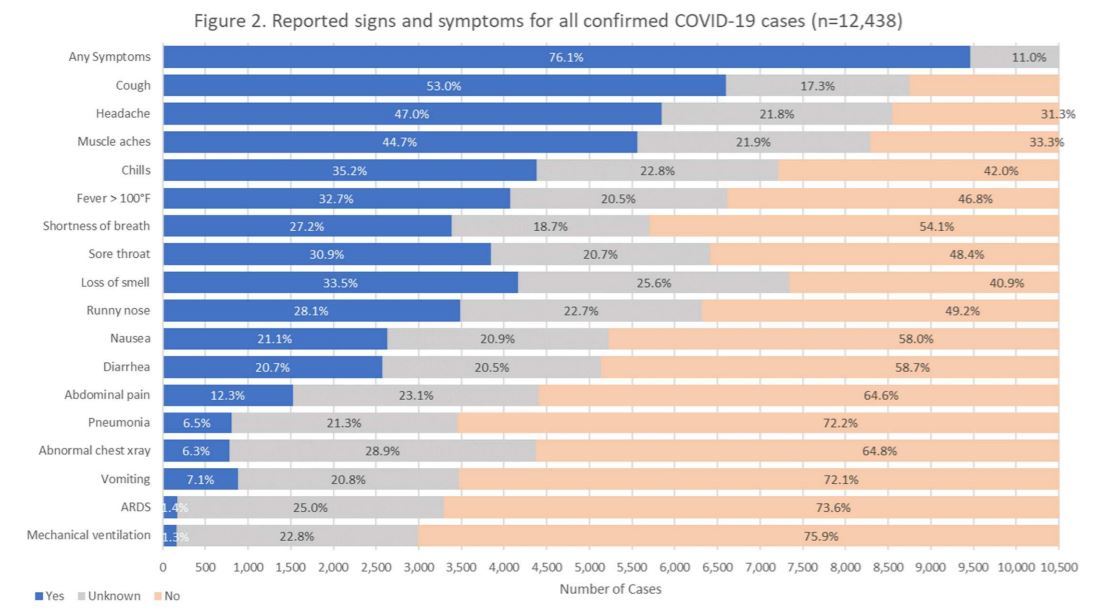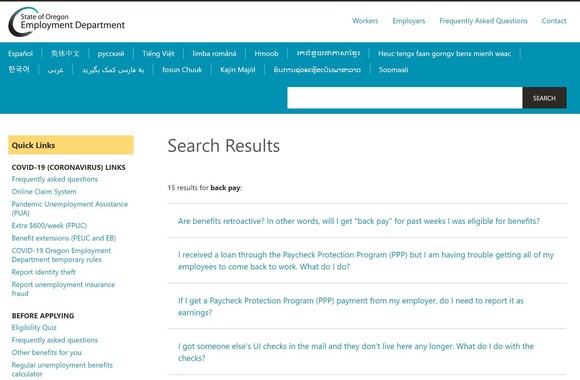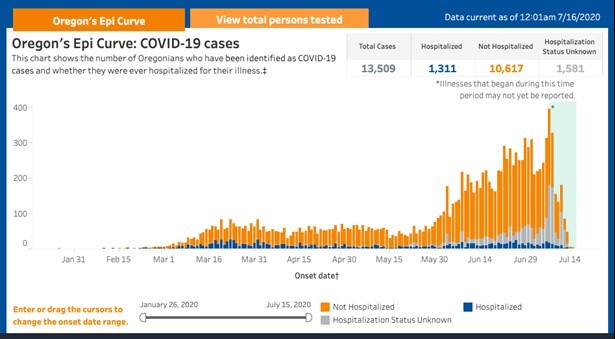|
Dear Friends and Neighbors,
Today, Oregon set a new daily record high for recorded coronavirus cases. The 437 new diagnosed cases well exceed the previous record (409), marking the second time the state has recorded more than 400 cases in a single day.
The Oregon Health Authority’s weekly report on the virus shows that the resurgence of coronavirus in the state “accelerated” last week. Of the people tested between July 6-12, 6.2% of tests came back positive. This is up from the previous week’s rate of 5.0%. Twenty-two Oregonians passed away, twice as many as the previous week.
It’s discouraging to see why this is happening. According to the Oregon Health Authority, the rise in cases is attributed to new infections from social gatherings and sporadic spread across communities. This indicates that some Oregonians are letting their guards down when getting together with family and friends, which is among the reasons Governor Brown has banned indoor gatherings of more than 10 people.
While we all know that Zoom and phone calls are no substitute for seeing family and friends in person, please try to limit these interactions as much as possible. When you do get together with others, smaller groups and being outdoors are always better. This virus is as contagious as ever, and we must all get back to the frame of mind we had when Stay Home, Save Lives first went into effect in late March.
Additionally, worksite outbreaks and long-term care facility outbreaks are also contributing cases to the daily count. We also continue to see an increase in the portion of cases among younger people, and continue to see disproportionate numbers of cases among communities of color.
Heading into another weekend of wonderful weather, let’s each remember to do our part to protect one another and be safe. It’s also important to keep in mind that we know how to push this thing back and there is still reason to have hope.
Daily cases have plateaued for the first time since late May, and hospitalizations plateaued after rising each of the last five weeks. This is likely due in part to younger Oregonians being infected at an increasingly higher rate, as they are less likely to be hospitalized with the virus. Currently, our hospitalizations peaked in March and April.
Other countries have shown that it is possible to get a handle on this virus. Life is not returning to normal any time soon, so we must shake ourselves out of any complacency if we’re going to save as many lives as possible.
The weekly report notes the top symptoms remain cough, headache, muscle aches, chills, and fever over 100 degrees. If you’re experiencing these symptoms, you should stay home and reach out to your doctor about getting tested.

When COVID-19 deaths get reported, we regularly read that individuals who have died had “underlying conditions.” I think this might give a false sense of security. We might think that the only people who will get really sick and die from this virus will be people who are already really sick. So, let’s explore this a bit.
According to a recent email exchange with the Oregon Health Authority, about 48% of all reported cases in Oregon were people with underlying conditions, with 40% having no underlying conditions and 12% unknown. The percentage of people who get infected and who have underlying medical conditions seems to be dropping as more of the cases occur in younger and healthier people.
Nearly everyone who has died from COVID-19 in Oregon is reported to have had an underlying health condition. Deaths have been highly concentrated among older people (almost 50% over 80 years of age and more than 90% over 60 years of age), which is also the population that tends to have more underlying medical conditions.
The federal Centers for Disease Control and Prevention (CDC) is the best source of data on underlying medical conditions. You can find the CDC information here.
It might surprise you to know that some of these conditions are fairly common:
- Asthma (moderate-to-severe)
- Hypertension or high blood pressure
- Pregnancy
- Diabetes (Type 1 and Type 2)
- Smoking
- Obesity (body mass index [BMI] of 30 or higher)
- COPD (chronic obstructive pulmonary disease)
- Serious heart conditions, such as heart failure, coronary artery disease, or cardiomyopathies
- Neurologic conditions, such as dementia
And, of course, conditions that are less common put people at risk:
- Chronic kidney disease
- Immunocompromised state (weakened immune system) from solid organ transplant, from blood or bone marrow transplant, immune deficiencies, HIV, use of corticosteroids, or use of other immune weakening medicines
- Sickle cell disease
- Cerebrovascular disease (affects blood vessels and blood supply to the brain)
- Cystic fibrosis
- Liver disease
- Pulmonary fibrosis (having damaged or scarred lung tissues)
- Thalassemia (a type of blood disorder)
- Children who are medically complex, who have neurologic, genetic, metabolic conditions, or who have congenital heart disease.
The CDC has the best information about exactly how many people who are hospitalized with COVID-19 had which medical conditions. You can find that information here.
So, please be careful, take precautions, and don’t think you’re invincible. An “underlying condition” can be something fairly common. It’s not just really sick people who get hospitalized or die when they get coronavirus.
On Tuesday, I mentioned that the Oregon Employment Department has a new website (found here) designed to help out-of-work Oregonians navigate the complex benefits system.
Among the features I’d like to highlight is the Frequently Asked Questions (FAQs) section and accompanying search bar at the top. I frequently use this newsletter to share answers from the department to questions we get most often about unemployment benefits.
The new site now has compiled nearly 150 FAQs, many of which came from Oregonians through legislators or social media. This list of questions and answers is being frequently updated. My office continues to pass along more complicated questions from constituents to the department to get them direct answers. Please continue to send any questions that aren’t answered on the site. We will keep getting those to the department and request that they update the FAQ section so it can help more people with similar questions.

The section includes employee-specific questions on returning to work. I have pushed the department for an employee-specific FAQ section on its own, similar to its employer-specific one. I still hope that those questions will be centralized in a clearer manner on the site.
Unfortunately, an online Pandemic Unemployment Assistance (PUA) Program application has not yet launched. It’s expected to be available within the next few business days.
The economic devastation caused by the pandemic punched a big hole in our state government’s two-year budget. Unlike the federal government, Oregon needs to have a balanced budget. So, the Legislature will have to return for another special session soon to fix the budget.
Today, the three co-chairs of the Joint Committee on Ways and Means released their budget rebalance proposal. You can read the full 13-page proposal here.
Here’s an excerpt from the release:
In the face of an unprecedented economic and public health crisis caused by the COVID-19 pandemic, the co-chairs worked to ensure that their proposal maintained essential services that Oregonians depend on, including critical investments in public education, health care, child welfare, housing and more. Maintaining these programs will be crucial in order to protect vulnerable Oregonians, put the state on a path to recovery and work toward economic resilience.
The proposal judiciously uses a portion of the Education Stability Fund to spare students and teachers from devastating program cuts amid the uncertainty of the pandemic, while preserving a strong level of reserves to help weather upcoming budget cycles when state revenue is projected to further decline due to the dramatic impact the of the pandemic on Oregon’s economy.
The scale of this crisis highlights the critical need for further federal action to support state investments in essential services that provide safety and security for all Oregonians, including the state’s most vulnerable populations.
There will be opportunities for public feedback next week. The different Ways and Means Subcommittees will meet remotely to take testimony on the proposal:
Wednesday, July 22:
Natural Resources: 9 am - 12 pm
General Government: 1 pm - 4 pm
Thursday, July 23:
Education: 9 am - 12 pm
Human Services: 1 pm - 4 pm
Friday, July 24:
Public Safety: 9 am -12 pm
Transportation and Economic Development: 1 pm - 4 pm
I will have more information on Monday about these meetings.
- The Oregon Health Authority reported 437 new confirmed cases of coronavirus, bringing the statewide total of new and presumptive cases to 13,509. Sadly, two more people have died, meaning there have been 249 Oregonians to die of the coronavirus. On Wednesday, there were 282 new confirmed cases and seven people passed away. You can click the images below for links to interactive data tables about coronavirus in Oregon.


To read past newsletters, you can go to this link. For up to date information, please check this link to the Oregon Health Authority where regular updates are posted: https://www.oregon.gov/oha/ERD/Pages/News-Releases.aspx
Please email me at Rep.TinaKotek@oregonlegislature.gov if you have specific concerns that have not been addressed by the OHA. Our office will do all we can to help and protect all Oregonians.
Thank you for reading! We will get through this together.
Best,

Tina Kotek
State Representative
House District 44
Speaker of the House
email: Rep.TinaKotek@oregonlegislature.gov I phone: 503-986-1200
address: 900 Court St NE, H-269, Salem, OR 97301
website: http://www.oregonlegislature.gov/kotek
|